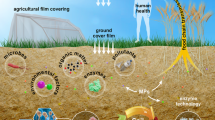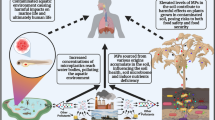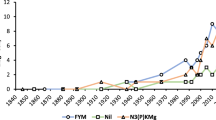Abstract
Microplastic pollution in soils is a recent environmental problem and the lack of knowledge about the impacts and the extent of the problem are raising questions and concerns among researchers and politicians. Using a normative simulation model, we assess the extent of microplastic pollution in German agricultural soils originating from the land application of sewage sludge and compost. We estimate the microplastic concentration in German agricultural soils, the area of polluted land, and we compare the efficiency and effectiveness of some selected abatement measures. For 2020, we estimate that microplastic concentration in agricultural soil reaches a maximum concentration of between 30 and 50 mg/kg dry weight on 2% of utilised agricultural area and a marginal concentration on 22% of utilised agricultural area. Without the implementation of abatement measures, we expect the microplastic concentration to increase two to three times by 2060. Assessing the abatement measures, we find that for sewage sludge, thermal recycling is a more efficient and effective than equipping washing machines with microplastic-filters in private households. The use of plastic detection systems in the biowaste collection process reduces the plastic content of the compost and thus the release of microplastic into the soil. Detection systems are a more efficient measure for compost than thermal recycling. Concerning sludge, the findings indicate that the German strategy of thermally recycling sewage sludge is an efficient and effective measure to reduce microplastic pollution in soils. Reducing the plastic content of collected biowaste complies with the principles of a circular economy.





Similar content being viewed by others
Availability of Data and Material
Data is available on request.
Code Availability
Not applicable.
Notes
i.e. 0.032% + 10% · 0.032% = 0.035% ~ 0.04%
In May 1993 the TASi (Technische Anleitung Siedlungsabfall) prohibited the disposal of organic waste (such as sewage sludge) in landfills [46].
References
Gestoso, I., Cacabelos, E., Ramalhosa, P., & Canning-Clode, J. (2019). Plasticrusts: A new potential threat in the Anthropocene’s rocky shores. Science of The Total Environment, 687, 413–415. https://doi.org/10.1016/j.scitotenv.2019.06.123
Horton, A. A., Walton, A., Spurgeon, D. J., Lahive, E., & Svendsen, C. (2017). Microplastics in freshwater and terrestrial environments: Evaluating the current understanding to identify the knowledge gaps and future research priorities. Science of The Total Environment, 586, 127–141. https://doi.org/10.1016/j.scitotenv.2017.01.190
Koelmans, A. A., Besseling, E., Foekema, E., Kooi, M., Mintenig, S., Ossendorp, B. C., & Scheffer, M. (2017). Risks of plastic debris: Unravelling fact, opinion, perception, and belief. Environmental Science & Technology, 51(20), 11513–11519. https://doi.org/10.1021/acs.est.7b02219
Zubris, K. A. V., & Richards, B. K. (2005). Synthetic fibers as an indicator of land application of sludge. Environmental Pollution, 138(2), 201–211. https://doi.org/10.1016/j.envpol.2005.04.013
Selonen, S., Dolar, A., Jemec Kokalj, A., Skalar, T., Parramon Dolcet, L., Hurley, R., & van Gestel, C. A. M. (2020). Exploring the impacts of plastics in soil – The effects of polyester textile fibers on soil invertebrates. Science of The Total Environment, 700, 134451. https://doi.org/10.1016/j.scitotenv.2019.134451
de Souza Machado, A. A., Kloas, W., Zarfl, C., Hempel, S., & Rillig, M. C. (2018). Microplastics as an emerging threat to terrestrial ecosystems. Global Change Biology, 24(4), 1405–1416. https://doi.org/10.1111/gcb.14020
Hurley, R. R., & Nizzetto, L. (2018). Fate and occurrence of micro(nano)plastics in soils: Knowledge gaps and possible risks. Current Opinion in Environmental Science & Health, 1, 6–11. https://doi.org/10.1016/j.coesh.2017.10.006
Nizzetto, L., Bussi, G., Futter, M. N., Butterfield, D., & Whitehead, P. G. (2016). A theoretical assessment of microplastic transport in river catchments and their retention by soils and river sediments. Environmental Science: Processes & Impacts, 18(8), 1050–1059. https://doi.org/10.1039/C6EM00206D
Rillig, M. C., Ingraffia, R., & de Souza Machado, A. A. (2017). Microplastic incorporation into soil in agroecosystems. Frontiers in Plant Science, 8. https://doi.org/10.3389/fpls.2017.01805
Büks, F., Loes van Schaik, N., & Kaupenjohann, M. (2020). What do we know about how the terrestrial multicellular soil fauna reacts to microplastic? The Soil, 6(2), 245–267. https://doi.org/10.5194/soil-6-245-2020
Rillig, M. C., Lehmann, A., Ryo, M., & Bergmann, J. (2019). Shaping up: Toward considering the shape and form of pollutants. Environmental Science & Technology, 53(14), 7925–7926. https://doi.org/10.1021/acs.est.9b03520
Ng, E.-L., Huerta Lwanga, E., Eldridge, S. M., Johnston, P., Hu, H.-W., Geissen, V., & Chen, D. (2018). An overview of microplastic and nanoplastic pollution in agroecosystems. Science of The Total Environment, 627, 1377–1388. https://doi.org/10.1016/j.scitotenv.2018.01.341
Henseler, M., Brandes, E., & Kreins, P. (2020). Microplastics in agricultural soils: A new challenge not only for agro-environmental policy? Journal of Applied Business and Economics, 22(7). https://doi.org/10.33423/jabe.v22i7.3250
Brodhagen, M., Goldberger, J. R., Hayes, D. G., Inglis, D. A., Marsh, T. L., & Miles, C. (2017). Policy considerations for limiting unintended residual plastic in agricultural soils. Environmental Science & Policy, 69, 81–84. https://doi.org/10.1016/j.envsci.2016.12.014
Lehmann, A., Fitschen, K., & Rillig, M. C. (2019). Abiotic and biotic factors influencing the effect of microplastic on soil aggregation. Soil Systems, 3(1), 21. https://doi.org/10.3390/soilsystems3010021
Hahladakis, J. N., Velis, C. A., Weber, R., Iacovidou, E., & Purnell, P. (2018). An overview of chemical additives present in plastics: Migration, release, fate and environmental impact during their use, disposal and recycling. Journal of Hazardous Materials, 344, 179–199. https://doi.org/10.1016/j.jhazmat.2017.10.014
Shi, J., Sanganyado, E., Wang, L., Li, P., Li, X., & Liu, W. (2020). Organic pollutants in sedimentary microplastics from eastern Guangdong: Spatial distribution and source identification. Ecotoxicology and Environmental Safety, 193, 110356. https://doi.org/10.1016/j.ecoenv.2020.110356
Wang, J., Liu, X., Li, Y., Powell, T., Wang, X., Wang, G., & Zhang, P. (2019). Microplastics as contaminants in the soil environment: A mini-review. Science of The Total Environment, 691, 848–857. https://doi.org/10.1016/j.scitotenv.2019.07.209
Bakir, A., Rowland, S. J., & Thompson, R. C. (2014). Enhanced desorption of persistent organic pollutants from microplastics under simulated physiological conditions. Environmental Pollution, 185, 16–23. https://doi.org/10.1016/j.envpol.2013.10.007
Eerkes-Medrano, D., Thompson, R. C., & Aldridge, D. C. (2015). Microplastics in freshwater systems: A review of the emerging threats, identification of knowledge gaps and prioritisation of research needs. Water Research, 75, 63–82. https://doi.org/10.1016/j.watres.2015.02.012
Lusher, A. L., Hollman, P. C. H., & Mendoza-Hill, J. J. (2017). Microplastics in fisheries and aquaculture: status of knowledge on their occurrence and implications for aquatic organisms and food safety. Rome, Italy: FAO. Retrieved February 21, 2022, from https://www.fao.org/documents/card/fr/c/59bfa1fc-0875-4216-bd33-55b6003cfad8/
Corradini, F., Meza, P., Eguiluz, R., Casado, F., Huerta-Lwanga, E., & Geissen, V. (2019). Evidence of microplastic accumulation in agricultural soils from sewage sludge disposal. Science of The Total Environment, 671, 411–420. https://doi.org/10.1016/j.scitotenv.2019.03.368
Kay, P., Hiscoe, R., Moberley, I., Bajic, L., & McKenna, N. (2018). Wastewater treatment plants as a source of microplastics in river catchments. Environmental Science and Pollution Research, 25(20), 20264–20267. https://doi.org/10.1007/s11356-018-2070-7
Wijesekara, H., Bolan, N. S., Bradney, L., Obadamudalige, N., Seshadri, B., Kunhikrishnan, A., & Vithanage, M. (2018). Trace element dynamics of biosolids-derived microbeads. Chemosphere, 199, 331–339. https://doi.org/10.1016/j.chemosphere.2018.01.166
Bläsing, M., & Amelung, W. (2018). Plastics in soil: Analytical methods and possible sources. Science of The Total Environment, 612, 422–435. https://doi.org/10.1016/j.scitotenv.2017.08.086
Weithmann, N., Möller, J. N., Löder, M. G. J., Piehl, S., Laforsch, C., & Freitag, R. (2018). Organic fertilizer as a vehicle for the entry of microplastic into the environment. Science Advances, 4(4), eaap8060. https://doi.org/10.1126/sciadv.aap8060
Brennholt, N., Heß, M., & Reifferscheid, G. (2018). Freshwater microplastics: Challenges for regulation and management. In M. Wagner & S. Lambert (Eds.), Freshwater Microplastics - The Handbook of Environmental Chemistry (Vol. 58). Cham: Springer. https://doi.org/10.1007/978-3-319-61615-5
Möller, J. N., Löder, M. G. J., & Laforsch, C. (2020). Finding microplastics in soils: A review of analytical methods. Environmental Science & Technology, 54(4), 2078–2090. https://doi.org/10.1021/acs.est.9b04618
Wagner, M., Scherer, C., Alvarez-Muñoz, D., Brennholt, N., Bourrain, X., Buchinger, S., & Reifferscheid, G. (2014). Microplastics in freshwater ecosystems: What we know and what we need to know. Environmental Sciences Europe, 26(1), 12. https://doi.org/10.1186/s12302-014-0012-7
SAPEA. (2019). A scientific perspective on microplastics in nature and society. Science Advice for Policy by European Academies (SAPEA). https://doi.org/10.26356/microplastics
Bertling, J., Bertling, R., & Hammann, L. (2018). Kunststoffe in der Umwelt: Mikro- und Makroplastik. Ursachen, Mengen, Umweltschicksale, Wirkungen, Lösungsansätze, Empfehlungen. https://doi.org/10.24406/UMSICHT-N-497117
Kawecki, D., & Nowack, B. (2019). Polymer-specific modeling of the environmental emissions of seven commodity plastics as macro- and microplastics. Environmental Science & Technology, 53(16), 9664–9676. https://doi.org/10.1021/acs.est.9b02900
Conversio. (2020). Vom Land ins Meer – Modell zur Erfassung landbasierter Kunststoffabfälle. Conversio – Market and strategy. Retrieved February 21, 2022, from https://www.bkv-gmbh.de/studien/marine-litter-bericht-vom-land-ins-meer-modell-zur-erfassung-landbasierter-kunststoffabf%C3%A4lle-conversio.html
Brandes, E., Henseler, M., & Kreins, P. (2021). Identifying hot-spots for microplastic contamination in agricultural soils–Aspatial modelling approach for Germany. Environmental Research Letters, 16(10), 104041. https://doi.org/10.1088/1748-9326/ac21e6
Crossman, J., Hurley, R. R., Futter, M., & Nizzetto, L. (2020). Transfer and transport of microplastics from biosolids to agricultural soils and the wider environment. Science of The Total Environment, 724, 138334. https://doi.org/10.1016/j.scitotenv.2020.138334
Okoffo, E. D., Tscharke, B. J., O’Brien, J. W., O’Brien, S., Ribeiro, F., Burrows, S. D., & Thomas, K. V. (2020). Release of plastics to Australian land from biosolids end-use. Environmental Science & Technology, 54(23), 15132–15141. https://doi.org/10.1021/acs.est.0c05867
Kehres, B. (2019). Kunststoffe in Kompost und Gärprodukten Herkunft - Bedeutung - Vermeidung. BGK Information. Bundesgütegemeinschaft Kompost (BGK). Retrieved February 21, 2022, from https://www.kompost.de
BGK. (2018). Kunststoffe in Kompost und Gärprodukten. Humuswirtschaft und Kompost Aktuell, (Q4 2018).
AbfKlärV. (2017). Verordnung über die Verwertung von Klärschlamm, Klärschlammgemisch und Klärschlammkompost (Klärschlammverordnung - AbfKlärV). Federal Ministry of Justice. Retrieved February 21, 2022, from https://www.gesetze-im-internet.de/abfkl_rv_2017/BJNR346510017.html
BioAbfV. (2017). Verordnung über die Verwertung von Bioabfällen auf landwirtschaftlich, forstwirtschaftlich und gärtnerisch genutzten Böden (Bioabfallverordnung - BioAbfV). Federal Ministry of Justice. Retrieved February 21, 2022, from https://www.gesetze-im-internet.de/bioabfv/
BMEL. (2019). Statistisches Jahrbuch über Ernährung, Landwirtschaft und Forsten (2019): Verbleib von Kompost und Klärschlamm. Federal Minister of Food and Agriculture (BMEL). Retrieved February 21, 2022, from https://bmel-statistik.de/fileadmin/daten/SJT-3060620-0000.xlsx
Statistisches Bundesamt and DWA-Arbeitsgruppe KEK-1.2 Statistik. (2014). Abwasser und Klärschlamm in Deutschland – Statistische Betrachtungen Teil 1: Abwasserbehandlung. Korrespondenz Abwasser, Abfall, 61(12). Retrieved February 21, 2022, from https://www.destatis.de/DE/Themen/Gesellschaft-Umwelt/Umwelt/Wasserwirtschaft/Publikationen/Downloads-Wasserwirtschaft/abwasser-klaerschlamm-5322102159004.pdf?__blob=publicationFile&v=5
Statistisches Bundesamt and DWA-Arbeitsgruppe KEK-1.2 Statistik. (2015). Abwasser und Klärschlamm in Deutschland – statistische Betrachtungen Teil 2: Klärschlamm, Klärgas, Rechen und Sandfanggut. Korrespondenz Abwasser, Abfall, 62(1). Retrieved February 21, 2022, from https://www.destatis.de/DE/Themen/Gesellschaft-Umwelt/Umwelt/Wasserwirtschaft/Publikationen/Downloads-Wasserwirtschaft/abwasser-klaerschlamm-5322102159004.pdf?__blob=publicationFile&v=5
UBA. (2020). Bioabfälle-Data-Set: An Bioabfallbehandlungsanlagen angelieferte biologisch abbaubare Abfälle. Umweltbundesamt (UBA). Retrieved February 21, 2022, from https://www.umweltbundesamt.de/bild/an-bioabfallbehandlungsanlagen-angelieferte
Gallenkemper, B., & Dohmann, M. (1994). Klärschlamm-Entsorgung. Economica-Verlag.
TASi. (1993). Technische Anleitung zur Verwertung, Behandlung und sonstigen Entsorgung von Siedlungsabfällen. Umwelt-Online. Retrieved February 21, 2022, from https://www.umwelt-online.de/recht/abfall/ta_siedl/taa_ges.htm
Franck, J., & Schröder, L. (2015). Zukunftsfähigkeit kleiner Klärschlammverbrennungsanlagen. In J. Thomé-Kozmiensk, & M. Beckmann (Eds.), Energie aus Abfall (pp. 457–476). TK Verlag Karl Thomé-Kozmiensky. Retrieved February 21, 2022, from https://www.vivis.de/2015/12/zukunftsfaehigkeit-kleiner-klaerschlammverbrennungsanlagen/8862/
KrWG. (2012). Gesetz zur Förderung der Kreislaufwirtschaft und Sicherung der umweltverträglichen Bewirtschaftung von Abfällen: Abfallhierarchie (KrWG). Federal Ministry of Justice. Retrieved February 21, 2022, from https://www.gesetze-im-internet.de/krwg/__6.html
Aqua Consult Baltic. (2015). Ausarbeitung der Lösungen zur regionalen Klärschlammaufbereitung sowie Ausarbeitung der Kriterien zum Ende der Abfalleigenschaft von Klärschlamm. Aqua Consult Baltic. Retrieved February 21, 2022, from https://ec.europa.eu/growth/tools-databases/tris/hr/index.cfm/search/?trisaction=search.detail&year=2017&num=154&iLang=DE
LfU. (2020). Klärschlamm – Entsorgungssituation. Bayerisches Landesamt für Umwelt (LfU). Retrieved February 21, 2022, from https://www.lfu.bayern.de/abfall/klaerschlamm/index.htm
StaLA-BW. (2021). Landwirtschaftliche Klärschlammverwertung ist die Ausnahme -- Baden-Württemberg: In der Mehrzahl der Kreise wurde der gesamte Klärschlamm verbrannt. Statistischen Landesamt Baden Württemberg (StaLa-BW). Retrieved February 21, 2022, from http://www.statistik-bw.de/Presse/Pressemitteilungen/2021008
UM-BW. (2021). Entsorgung – Klärschlämme. Ministerium für Umwelt, Klima und Energiewirtschaft Baden-Württemberg (UM-BW). Retrieved February 21, 2022, from https://um.baden-wuerttemberg.de/de/umwelt-natur/abfall-und-kreislaufwirtschaft/abfallstroeme/abfallarten-und-ihre-entsorgung/klaerschlaemme/
Roskosch, A., & Heidecke, P. (2018). Klärschlammentsorgung in der Bundesrepublik Deutschland. Umweltbundesamt (UBA). Retrieved February 21, 2022, from https://www.umweltbundesamt.de/publikationen/klaerschlammentsorgung-in-der-bundesrepublik
Herrmann, T., Weiss, V., Bannick, C., Ehlers, K., & Claussen, U. (2017). Bioabfallkomposte und -gärreste in der Landwirtschaft. Umwelt Bundesamt (UBA). Retrieved February 21, 2022, from https://www.umweltbundesamt.de/publikationen/bioabfallkomposte-gaerreste-in-der-landwirtschaft
Ministère de la Transition écologique et solidaire. (2020). Lutte contre la pollution plastique : Brune Poirson reçoit les fabricants de machines à laver. Ministère de la Transition écologique et solidaire. Retrieved February 21, 2022, from https://www.ecologique-solidaire.gouv.fr/lutte-contre-pollution-plastique-brune-poirson-recoit-fabricants-machines-laver
European Union. (2012). Consolidated version of the treaty on the functioning of the European Union (TFEU). Official Journal of the European Union. Retrieved February 21, 2022, from https://eur-lex.europa.eu/legal-content/EN/TXT/PDF/?uri=CELEX:12012E/TXT&from=EN
European Union. (2020). Circular economy action plan. for a cleaner and more competitive. Europe. European Commission. Retrieved February 21, 2022, from https://ec.europa.eu/environment/circular-economy/pdf/new_circular_economy_action_plan.pdf
VAK. (2021). Refuse collection vehicles - Environment and safety details make the difference. Verband der Arbeitsgeräte- und Kommunalfahrzeug-Industrie e.V. (VAK). Retrieved February 21, 2022, from https://www.vak-ev.de/en/members/refuse-collection-vehicles
European Commission. (2019). The European green deal. European Commission. Retrieved February 21, 2022, from https://eur-lex.europa.eu/legal-content/EN/TXT/?qid=1596443911913&uri=CELEX:52019DC0640#document2
European Union. (2021). New soil strategy - Healthy soil for a healthy life. European Commission. Retrieved February 21, 2022, from https://ec.europa.eu/info/law/better-regulation/have-your-say/initiatives/12634-Healthy-soils-new-EU-soil-strategy_en
Hagens, N. J. (2020). Economics for the future – Beyond the superorganism. Ecological Economics, 169, 106520. https://doi.org/10.1016/j.ecolecon.2019.106520
Melgar-Melgar, R. E., & Hall, C. A. S. (2020). Why ecological economics needs to return to its roots: The biophysical foundation of socio-economic systems. Ecological Economics, 169, 106567. https://doi.org/10.1016/j.ecolecon.2019.106567
Acknowledgements
We thank three anonymous reviewers and the editor whose comments and suggestions helped improve this article.
Funding
Partial financial support was received from the German Federal Ministry of Education and Research (BMBF) within the project PLAWES (Grant Number 03F0789G).
Author information
Authors and Affiliations
Contributions
Martin Henseler: Conceptualisation, data curation, formal analysis, methodology, software, validation, visualisation, writing – original draft. Micheal B. Gallagher: Writing – review & editing. Peter Kreins: Funding acquisition, project administration.
Corresponding author
Ethics declarations
Ethics Approval
Not applicable.
Consent to Participate
Not applicable.
Consent for Publication
Not applicable.
Conflict of Interest
The authors declare no competing interests.
Additional information
Publisher's Note
Springer Nature remains neutral with regard to jurisdictional claims in published maps and institutional affiliations.
Supplementary Information
Below is the link to the electronic supplementary material.
Rights and permissions
About this article
Cite this article
Henseler, M., Gallagher, M.B. & Kreins, P. Microplastic Pollution in Agricultural Soils and Abatement Measures – a Model-Based Assessment for Germany. Environ Model Assess 27, 553–569 (2022). https://doi.org/10.1007/s10666-022-09826-5
Received:
Accepted:
Published:
Issue Date:
DOI: https://doi.org/10.1007/s10666-022-09826-5




